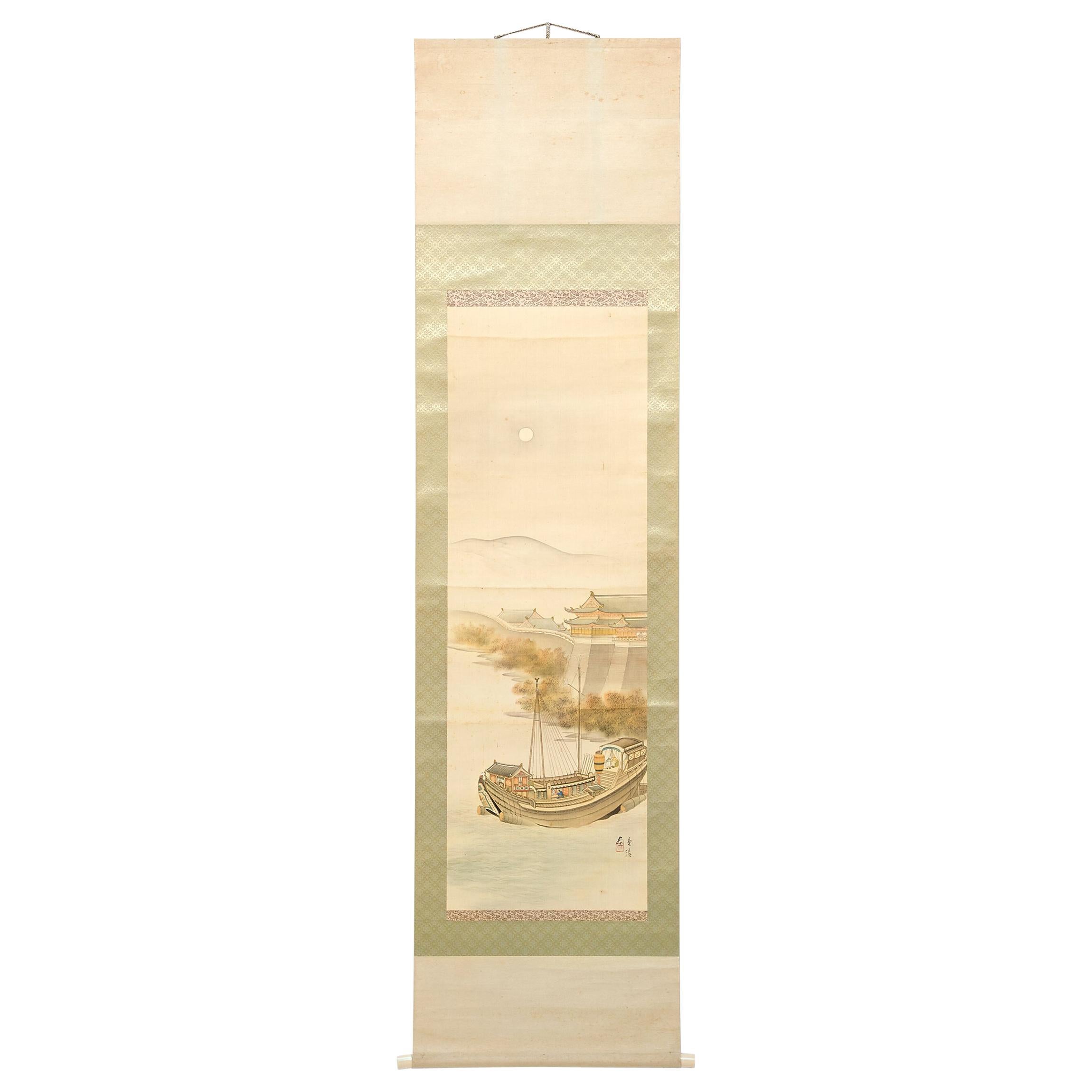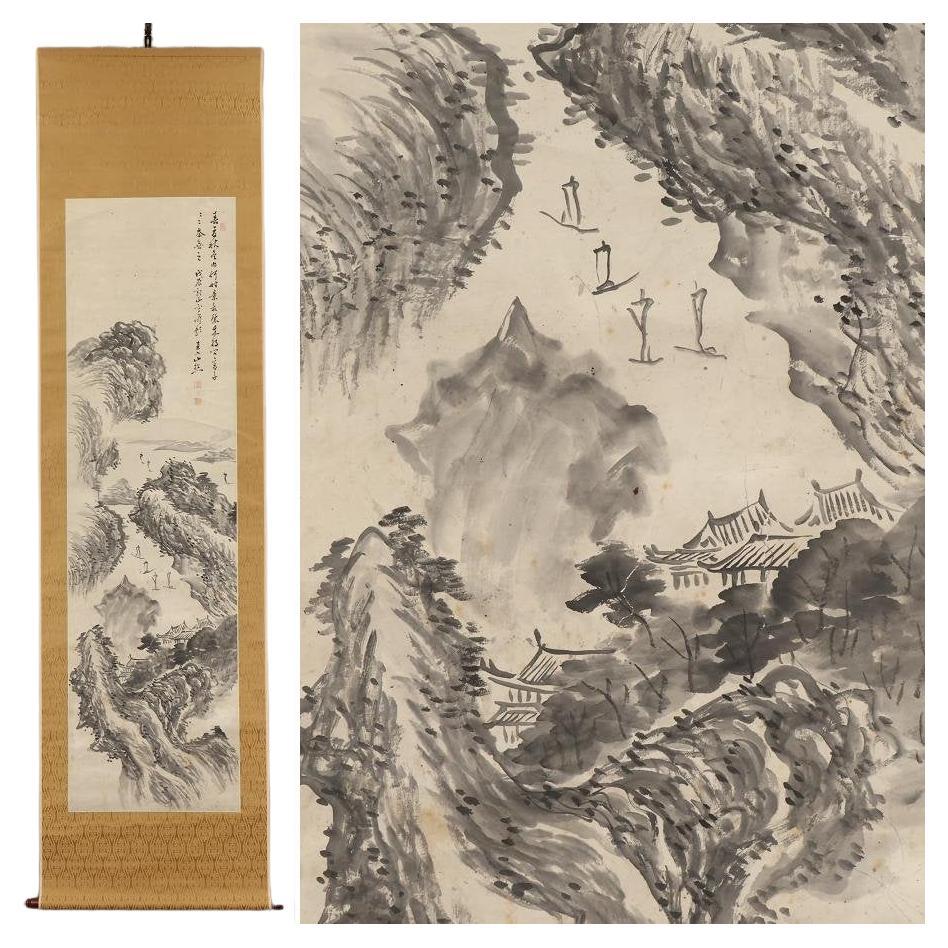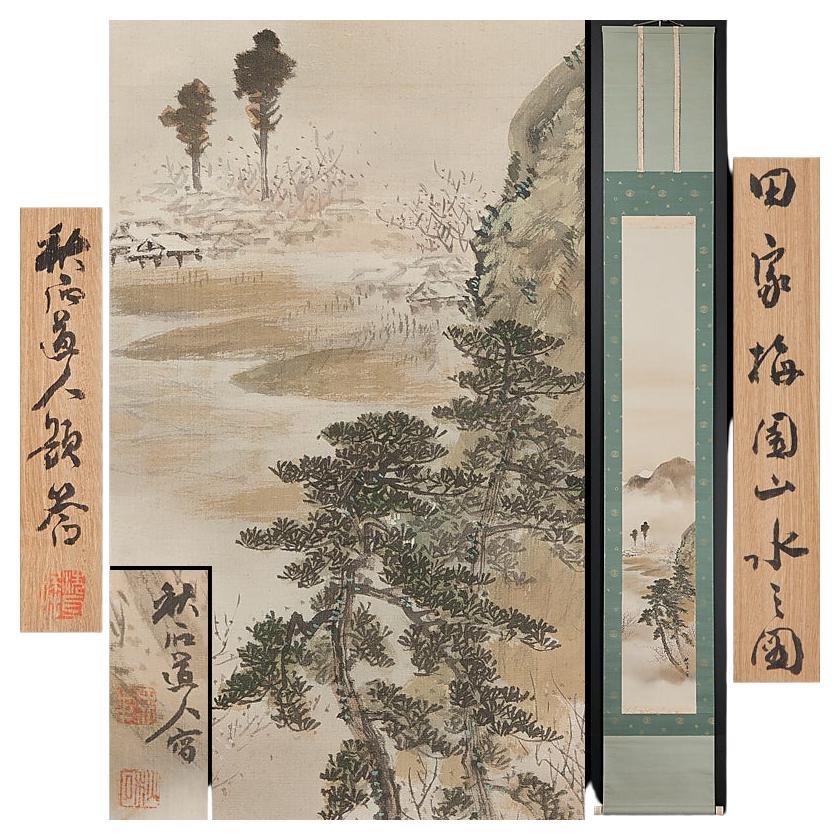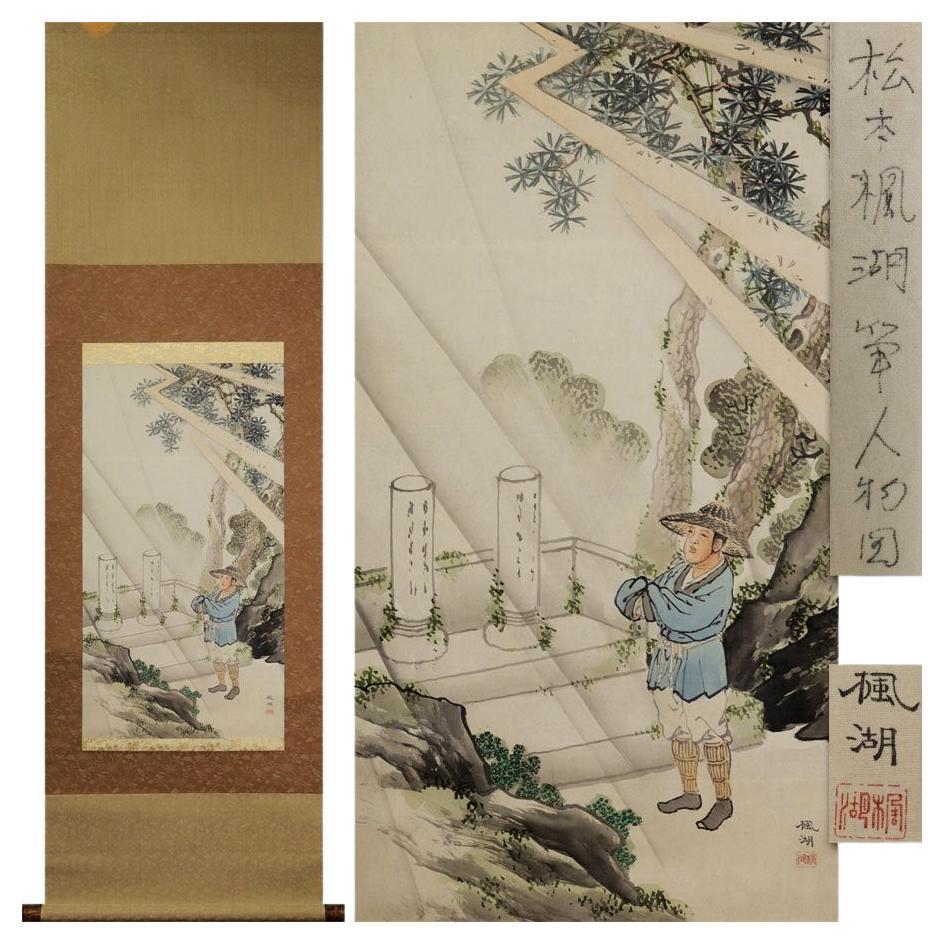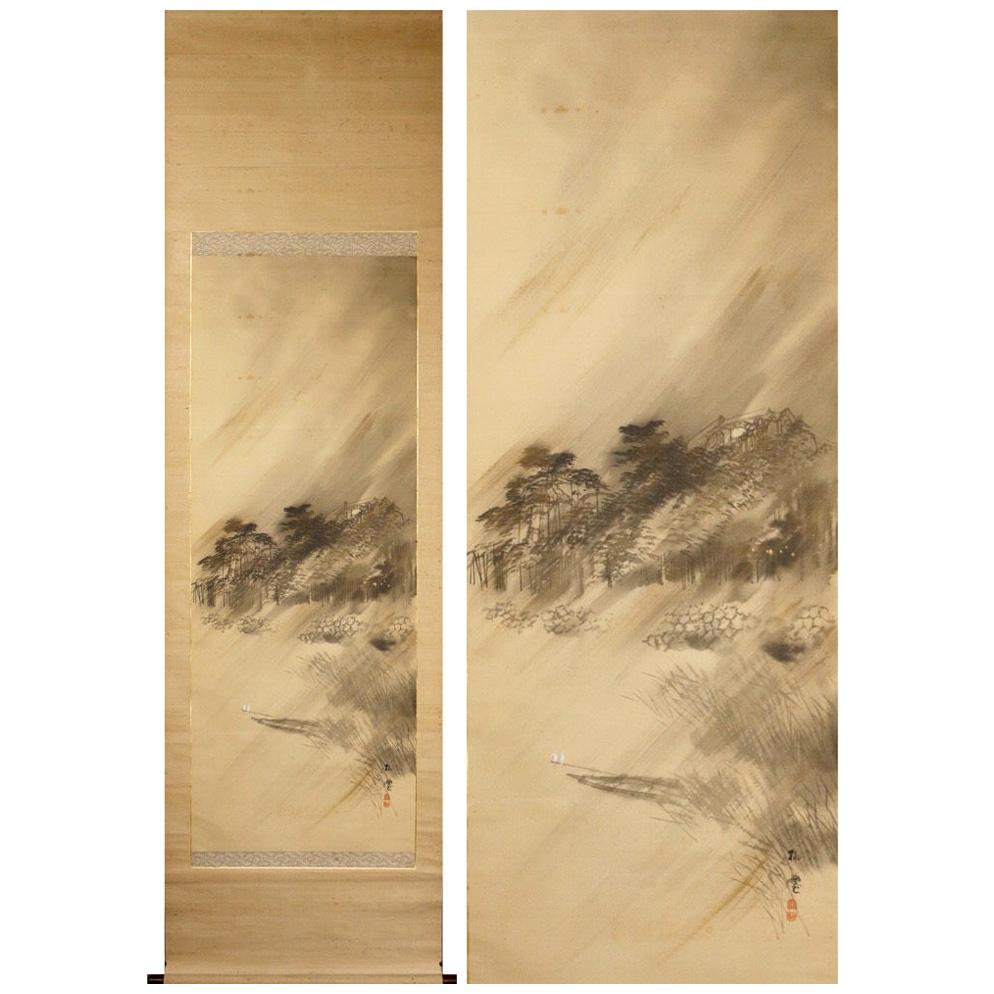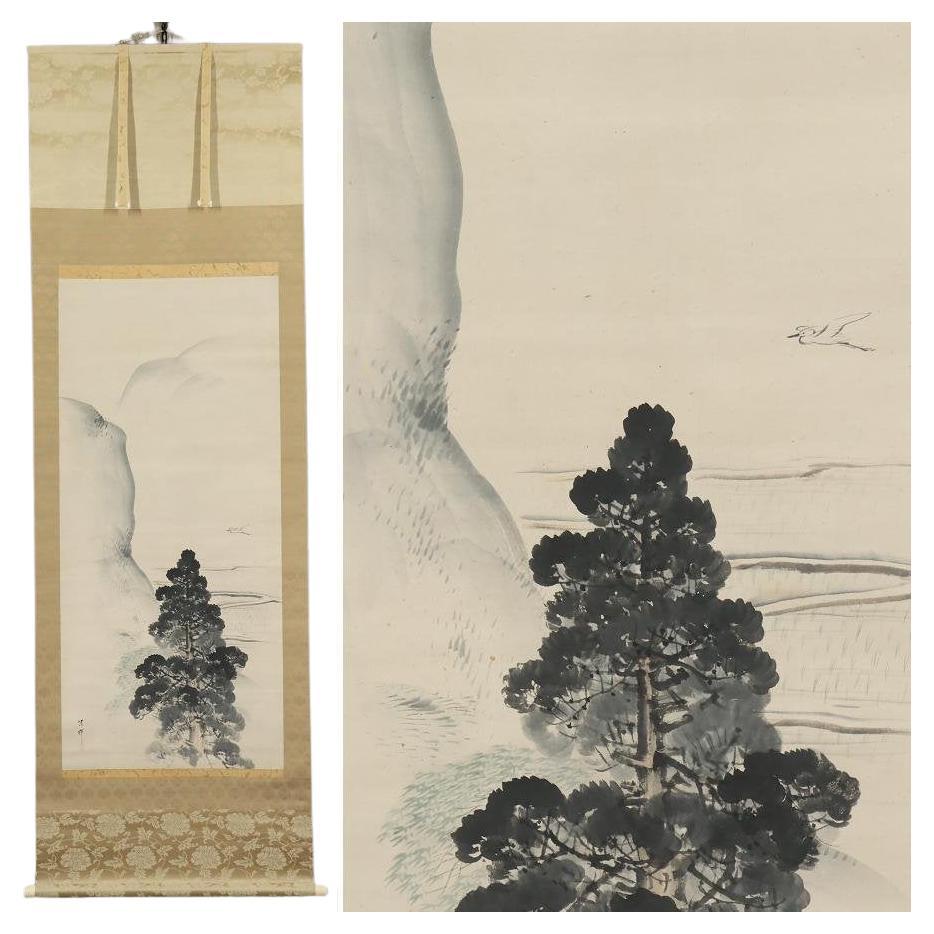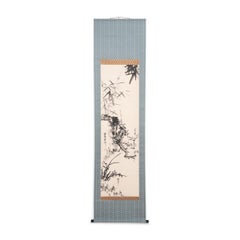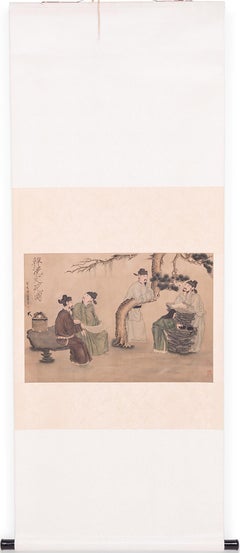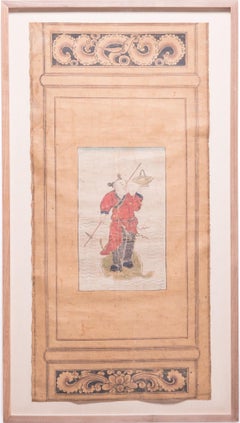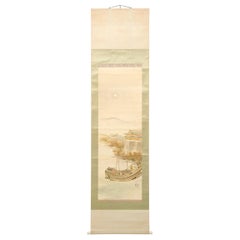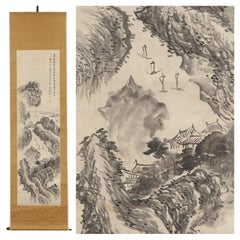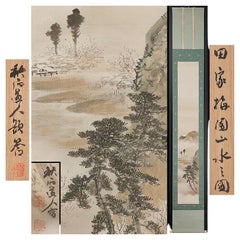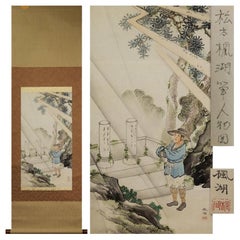Items Similar to Japanese Riverside Landscape Scroll, c. 1900
Want more images or videos?
Request additional images or videos from the seller
1 of 9
UnknownJapanese Riverside Landscape Scroll, c. 19001900
1900
$1,980
£1,512.41
€1,737.93
CA$2,826.46
A$3,099
CHF 1,618.27
MX$37,292.52
NOK 20,395.73
SEK 19,177.23
DKK 12,979.12
About the Item
Although Western painting was initially embraced during Japan’s Meiji period (1868–1912), artists brought on a revival of traditional painting styles as they sought to create a modern Japanese style with roots in the past. This exquisite hanging scroll demonstrates the preference for soft layering of gray tones with judicious use of color. The landscape is rendered in soft ink washes that subtly distinguish between water, mountain, and sky. The scroll painting illustrates human presence with intricate detail, bringing the grand estate and passenger boat into focus with dark outlines and careful brushstrokes. Delicately composed, this scroll perfectly captures the beauty of Meiji-era landscape painting.
- Creation Year:1900
- Dimensions:Height: 85 in (215.9 cm)Width: 23.5 in (59.69 cm)Depth: 1 in (2.54 cm)
- Medium:
- Period:
- Condition:
- Gallery Location:Chicago, IL
- Reference Number:Seller: CMKH0091stDibs: LU103639909192
About the Seller
5.0
Gold Seller
Premium sellers maintaining a 4.3+ rating and 24-hour response times
1stDibs seller since 2018
33 sales on 1stDibs
Typical response time: 12 hours
- ShippingRetrieving quote...Shipping from: Chicago, IL
- Return Policy
Authenticity Guarantee
In the unlikely event there’s an issue with an item’s authenticity, contact us within 1 year for a full refund. DetailsMoney-Back Guarantee
If your item is not as described, is damaged in transit, or does not arrive, contact us within 7 days for a full refund. Details24-Hour Cancellation
You have a 24-hour grace period in which to reconsider your purchase, with no questions asked.Vetted Professional Sellers
Our world-class sellers must adhere to strict standards for service and quality, maintaining the integrity of our listings.Price-Match Guarantee
If you find that a seller listed the same item for a lower price elsewhere, we’ll match it.Trusted Global Delivery
Our best-in-class carrier network provides specialized shipping options worldwide, including custom delivery.More From This Seller
View AllKorean Hanging Scroll of Bamboo, Prunus, and Orchids
Located in Chicago, IL
This Korean hanging scroll from the mid-20th century honors traditional calligraphy painting with delicate detail and a refined composition, thought to inspire clear and concise thinking. Expressing the beauty and resilience of nature’s flora, ink calligraphy artists traditionally select plants and flowers as the subjects of their works, each chosen for its auspicious meaning, literary resonance, or scholarly virtue.
This particular example depicts a quiet natural landscape of three plants growing side-by-side along a rocky hill. Strong bamboo stalks sway above a branch of delicate prunus branches, while elegant orchids blossom in the foreground. Each painted by a different artist, these sacred plants represent the cycle of the seasons: the plum blossom for winter, the orchid for spring, and the bamboo for summer. Brushed with black ink for a monochromatic expression, the painting relies on value rather than color to convey depth and texture within this simple setting. The collaborative painting is contrasted by a beautiful blue silk brocade border woven with a repeating pattern of blossoms and vines.
Each plant is signed individually in ink along with the artist’s seal.
Painting has been remounted. Includes a wooden scroll...
Category
Mid-20th Century Folk Art Landscape Drawings and Watercolors
Materials
Silk, Paper, Ink
Japanese Festival Folding Screen, Paint on Paper
Located in Chicago, IL
This folding screen is a stunning example of Japanese artistry. Beautifully painted with delicate brushwork, the evocative screen depicts a lively festival during the Edo period (1615–1912). The raucous scene is full of life; within the dense crowd, you can make out people dancing...
Category
19th Century Edo Figurative Paintings
Materials
Paper, Ink, Pigment
"Literary Garden, " Chinese Scroll Painting
Located in Chicago, IL
Exquisitely painted with delicate line work and a subdued color palette, this Chinese scroll painting is an early 20th century reproduction of a famous...
Category
Early 20th Century Qing Figurative Drawings and Watercolors
Materials
Silk, Paper, Ink
Chinese Mythical Immortal Screen Painting, c. 1850
Located in Chicago, IL
Since the 12th century, people in China have used folding screens and doors to partition and decorate their homes - the vivid scenes backing the screens added life and color to a room. This 19th-century painting is delicately brushed of gouache and ink on fabric and was originally part of a set of eight backing a wooden screen in northern China.
The figure depicted is one of the mythical Eight Immortals of Taoism. Said to have attained immortality through their studies of the natural world, each of the Eight Immortals represents a different condition in life and together they impart a blessing of prosperity and longevity. Depicted here is immortal Lan Caihe, the patron saint of florists and gardeners. Standing atop a lotus leaf in open water, they hold a gardening hoe in one hand and a basket for flowers...
Category
Mid-19th Century Qing Figurative Paintings
Materials
Fabric, Ink, Pigment
Chinese Lunar New Year Painted Scroll
Located in Chicago, IL
In celebration of the lunar new year festival, it was traditional all over China to hang special decorations. In a city called Wuqiang, local artists made lacquer scroll paintings laden with symbolism. This framed and finely rendered 19th century folk painting from Wuqiang features an imperial court official and his family dressed in their best silks. The young boy is dressed in a wonderfully patterned yellow robe to offer Shou Xing...
Category
Mid-19th Century Qing Figurative Drawings and Watercolors
Materials
Lacquer, Paper, Pigment
"Scholars' Treasures, " Qing-Dynasty Ink Painting on Fabric
Located in Chicago, IL
A scroll and a small lantern depicted in this 19th-century painting suggest the romantic notion of a Chinese scholar painting in the evening hours. Re...
Category
Mid-19th Century Qing Still-life Paintings
Materials
Silk, Ink, Pigment
You May Also Like
Japanese Meiji Riverside Scroll Painting, c. 1900
Located in Chicago, IL
Although western painting was initially embraced during Japan’s Meiji period (1868-1912), artists brought on a revival of traditional painting styles as they sought to create a modern Japanese style with roots in the past. This exquisite hanging scroll demonstrates the preference for soft layering of gray tones with judicious use of color. The landscape is rendered in soft ink washes that subtly distinguish between water, mountain, and sky. The scroll painting...
Category
Early 20th Century Japanese Meiji Paintings and Screens
Materials
Paper
Japanese Nihonga Painting 19th c Edo Scroll by Tonomura Chokunyu River landscape
Located in Amsterdam, Noord Holland
[Authentic work] ◆Tanomura Chokunyu ◆Ink painting landscape ◆Japanese painting ◆Handpainted ◆ Paper ◆ Hanging scroll ◆
Chokunyu Tanomura
1814 (Bunka 11) - 1907 (Meiji 40)
[Art yearbook appraised value 8 million yen]
"A child prodigy in painting, Tanomura Chokunyu originally modeled himself after the style of the famous Tanomura Chikuden (1777-1835), who had adopted him at the age of eight. After Chikuden's death, Chokunyu took up an intense study of imported Chinese paintings." Paul Berry in: Literati Modern, p.136.) - The certificate box was inscribed by Tajika Chikuson (1864-1922), one of Chokunyu's key disciples.
Around 1840, he studied Confucianism under Kotake Shinozaki in Osaka, deepened his friendships with Heihachiro Oshio and Tessai Tomioka through sencha, and began to be recognized as a painter.
Furthermore, in 1862, he founded and hosted the Seiwan Tea Ceremony (a sencha tea ceremony), which achieved great fame.
In 1868, he moved to Kyoto and participated in the establishment of the Kyoto Prefectural Painting School (opened in 1880), serving as its principal and making efforts to foster the next generation.Furthermore, in 1996, he established the Japan Nanga Association with Tessai and others, and established the Japan Nanga Association, which was established in modern Japan. He made a great contribution to painting and the southern painting...
Category
Antique 19th Century Edo Paintings
Materials
Silk
$1,704 Sale Price
20% Off
Japanese Nihonga Painting 1900 Meiji/Taisho Scroll Shûseki, Okutani Landscape
Located in Amsterdam, Noord Holland
Susheki Okutani "Takaya Plum Garden Landscape"
Silk, Colored, Authentic, Hanging Scroll, , Double Box
size Axis: Height 206.5cm Width 29.3cm
Drawing…Height 126.7cm Width 19.5cm *There may be slight differences in dimensions. Thank you for your understanding.
situation It is in good condition, but please note that there are some light stains.
Please check the image for details.
Thank you for your support.
Biography Akishi Okutani
Japanese painter. Born in Osaka. His name is Tsunejiro. He studied under Kansai Mori. From an early age, he exhibited his works at the Japan Painting Association and the Young People's Painting Association, which was led by Gaho Hashimoto and Gyokusho Kawabata, and won numerous awards. He also opened a private school...
Category
20th Century Taisho Paintings
Materials
Silk
$1,704 Sale Price
20% Off
Lovely Japanese 19/20th c Scroll by Matsumoto Fuko Nihonga Landscape Autumn
Located in Amsterdam, Noord Holland
The following is a "Tang Dynasty Figure" written by Fuko Matsumoto using a unique brush stroke.
[Matsumoto Fuuko]
1840-1923 Japanese painter from the Meiji to Taisho periods.
orn in...
Category
20th Century Paintings
Materials
Silk
$936 Sale Price
20% Off
Lovely Nihonga Scene Meiji/Taisho Period Scroll Japan Artist Landscape Miyahara
Located in Amsterdam, Noord Holland
It is a work drawn by Miyahara Yanagi as you can see.
It is a pine tree drawing of Karasaki that has a unique presence, and it is
very attractive as it goes well with smoke.
¦ S...
Category
Antique 19th Century Japanese Meiji Paintings and Screens
Materials
Silk
$1,185 Sale Price
20% Off
Japanese Nihonga Painting 19th c Edo Scroll by Seiki Yokoyama Landscape Shijo
Located in Amsterdam, Noord Holland
[Authentic work] ◆ Seiki Yokoyama ◆ Landscape ◆ Rural landscape ◆ Japanese painting ◆ Shijo school ◆ Hand-painted ◆ Paperback ◆ Hanging scroll ◆
Seiki Yokoyama
[Art yearbook appra...
Category
Antique 19th Century Edo Paintings
Materials
Silk
$1,230 Sale Price
20% Off
More Ways To Browse
Antique Scroll
Scrolls Art
Scroll Painting
Japan 1900
Silk Japanese Scrolls
Antique Japanese Scrolls
Hanging Scrolls
Antique Japanese Scroll Painting
Japanese Paper Scroll
Japanese Scroll Landscape Painting
Ink Scroll
Antique Japanese Drawings
Antique Japanese Watercolor Painting
Japanese Silk Painting Ink
Still Life Photography
Original Antique Paintings
Antique Frame Portrait
Venice Paintings
